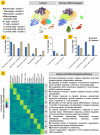Single-Cell Analysis of Host Responses in Bovine Milk Somatic Cells (bMSCs) Following HPAIV Bovine H5N1 Influenza Exposure
- PMID: 40573402
- PMCID: PMC12197475
- DOI: 10.3390/v17060811
Single-Cell Analysis of Host Responses in Bovine Milk Somatic Cells (bMSCs) Following HPAIV Bovine H5N1 Influenza Exposure
Abstract
The 2024 outbreak of highly pathogenic avian influenza virus (HPAIV) H5N1 in U.S. dairy cattle presented an unprecedented scenario where the virus infected bovine mammary glands and was detected in milk, raising serious concerns for public health and the dairy industry. Unlike previously described subclinical influenza A virus (IAV) infections in cattle, H5N1 infection induced severe clinical symptoms, including respiratory distress, mastitis, and abnormal milk production. To understand the host immune responses and changes, particularly in the mammary gland, we performed single-cell RNA sequencing analysis on bovine milk somatic cells (bMSCs) in vitro exposed to an H5N1 isolate from an infected dairy farm. We identified ten distinct cell clusters and observed a shift toward type-2 immune responses, characterized by T cells expressing IL13 and GATA3, and three different subtypes of epithelial cells based on the expression of genes associated with milk production. Our study revealed temporal dynamics in cytokine expression, with a rapid decline in luminal epithelial cells and an increase in macrophages and dendritic cells, suggesting a role in increased antigen presentation. While viral RNA was detected in bulk-exposed bMSC samples via qRT-PCR, no viral reads were observed in the scRNA-seq data, indicating that the immune responses captured may be due to exposure to viral components rather than productive infection. This research fills a critical gap in understanding the immune responses of bovine mammary glands to H5N1 exposure and highlights the need for further investigation into therapeutic strategies for managing such outbreaks.
Keywords: bovine H5N1; bovine milk somatic cells; single-cell RNA-seq.
Conflict of interest statement
The J.A.R. laboratory received support from Tonix Pharmaceuticals, Xing Technologies, and Zoetis, outside of the reported work. J.A.R. is an inventor of patents and patent applications on the use of antivirals and vaccines for the treatment and prevention of virus infections, owned by Kansas State University.
Figures



Similar articles
-
Outcomes of experimental infection of calves with swine influenza H3N2 virus.mBio. 2025 Jul 9;16(7):e0395724. doi: 10.1128/mbio.03957-24. Epub 2025 Jun 12. mBio. 2025. PMID: 40503902 Free PMC article.
-
Avian influenza A (H5N1) virus in dairy cattle: origin, evolution, and cross-species transmission.mBio. 2024 Dec 11;15(12):e0254224. doi: 10.1128/mbio.02542-24. Epub 2024 Nov 13. mBio. 2024. PMID: 39535188 Free PMC article. Review.
-
The emergence of highly pathogenic avian influenza H5N1 in dairy cattle: implications for public health, animal health, and pandemic preparedness.Eur J Clin Microbiol Infect Dis. 2025 Aug;44(8):1817-1833. doi: 10.1007/s10096-025-05147-z. Epub 2025 May 14. Eur J Clin Microbiol Infect Dis. 2025. PMID: 40369349 Free PMC article. Review.
-
Ocular infectivity and replication of a clade 2.3.4.4b A(H5N1) influenza virus associated with human conjunctivitis in a dairy farm worker in the USA: an in-vitro and ferret study.Lancet Microbe. 2025 Jul;6(7):101070. doi: 10.1016/j.lanmic.2024.101070. Epub 2025 Mar 17. Lancet Microbe. 2025. PMID: 40112840
-
Identification of amino acid residues in polymerase PB2 responsible for differential replication and pathogenicity of avian influenza virus H5N1 isolated from human and cattle in Texas, US.Emerg Microbes Infect. 2025 Dec;14(1):2542247. doi: 10.1080/22221751.2025.2542247. Epub 2025 Aug 20. Emerg Microbes Infect. 2025. PMID: 40747555 Free PMC article.
References
Publication types
MeSH terms
Substances
Associated data
- Actions
Grants and funding
LinkOut - more resources
Full Text Sources
Medical
Miscellaneous

